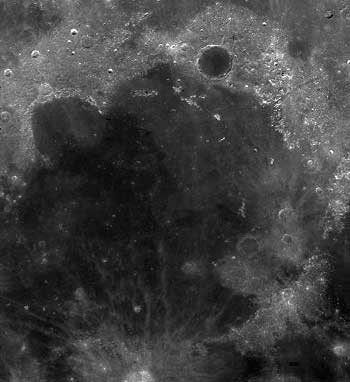8-15 billion years BP
(current estimate: 13 billion years BP) |
Big Bang (George Gamow and Ralph
Alpher, 1948)
Click here for
artist's representation of the big bang theory |
Stars and star cluster start to form 1 billion
years after the Big Bang
Helium is generated from hydrogen in stars, carbon from helium
Supernovae explosions generate the rest of the elements from the
periodic table and distribute heavier atoms in space
Our sun and planetary system form using heavier elements from the
supernova explosion 11 billion years BP |
| 4.5-5 billion years BP |
Earth and Moon form. Here is recent essay
on new findings on the impact |
| 4.03 billion years BP |
Oldest rocks on Earth (go here
for details on dating rocks)
(some characteristica of these rocks indicate that 4.3 billion years
ago the crust was already in contact with water, more here)
|
| about 4 billion years BP |
Mare Imbrium was
formed

[Photo is from NASA] |
| about 3.9 billion years BP |
End (tail) of the Early Heavy Bombardment |
| 3.85 billion years BP |
Oldest known sedimentary rocks, indications for liquid water,
rounded pebbles, and discrimination against heavy carbon isotopes is
detectable in organic material (just like modern biochemical
reactions).
Oldest geological evidence for life is based on 13C
discrimination (carbon derived from living systems often have lower
delta 13C values than inorganic carbonates) [here].
The rocks are from Akilia island off the coast of Greenland, and
severely altered by metamorphism. However, recently the evidence for
that was
reassessed.
|
| 3.5 billion years BP |
For about a decade the oldest microfossils were considered
to be about 3.5 Ga old (see
here). The fossils (as interpreted by Bill Schopf) look like
"modern" Cyanobacteria [bacteria that have O2 producing
photosynthesis]. Compare the time to to molecular trees of life: Is
this a problem? However, recently the evidence for these fossils was
questioned. |
| 3.2 billion years BP |
filamentous fossils, probably of thermophilic chemotrophic
prokaryotes (Rasmussen,
2000) |
| 2.7 billion years BP |
probable biomarkers of cyanobacteria and of eukaryotes (Roger
Summons, Roger Buick and Jochen Brocks) |
| 3.5 (?) -1.5 billion years BP |
microbial mats (-> stromatolites) dominate the biosphere
[What
are Stromatolites?] |
| 2 billion years BP |
Rise in atmospheric O2 |
| 1.2 billion years BP |
fossil red algae (bangiophytes) |
| 750 million years BP |
Possible "Snowball Earth"
event.
Scientific
American article by Hoffman and Schrag. The complete pdf is available " here - Ice entombed our planet hundreds of millions of years ago,
and complex animals evolved in the greenhouse heat wave that followed."
New book: "Snowball Earth: The Story of the Great Global
Catastrophe That Spawned Life As We Know It" by Gabrielle Walker,
Crown Publishing Group, 2003

|
| |
Ediacaran Fauna - A group of multicellular complex organism
(all extinct) here , and here
here |
| 600 million years BP |
Cambrian explosion -> origin of the different animal phyla |

